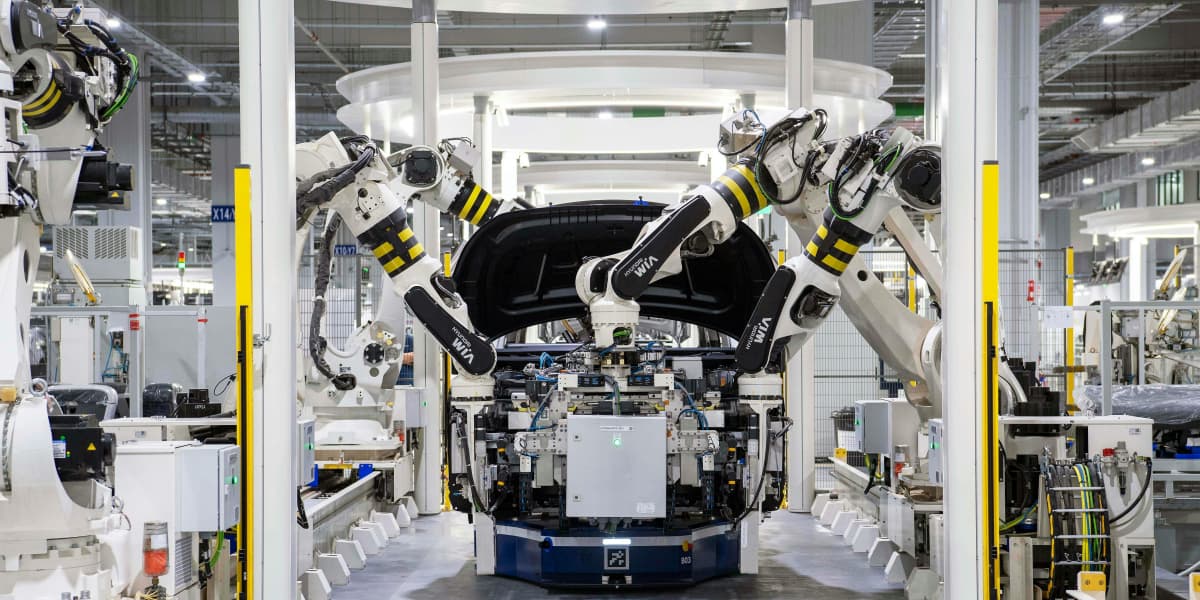Guía de iluminación LED industrial para fábricas

El aumento de las facturas de energía, las estrictas normas de seguridad y los tiempos de inactividad de la producción están obligando a los responsables de las instalaciones a replantearse la iluminación.
Esta guía práctica sobre iluminación LED industrial explica qué son los sistemas LED industriales, los estándares y tecnologías globales que los respaldan, cómo elegir las luminarias adecuadas, diseñar distribuciones eficientes y evaluar a los fabricantes confiables.
Encontrará especificaciones prácticas, listas de verificación comparativas y consejos orientados al retorno de la inversión para reducir los costos de energía, mejorar la visibilidad y la seguridad, y garantizar el cumplimiento normativo de las operaciones. Continúe leyendo para crear un plan de iluminación integral para su planta, almacén o taller.
Directorio:
1. ¿Qué es la iluminación LED industrial?
2. Comprensión de las normas globales de iluminación industrial
3. ¿Qué tecnologías impulsan la iluminación LED industrial moderna?
4. ¿Cuáles son los beneficios de utilizar luces LED industriales?
5. ¿Qué tipo de luz LED industrial necesita?
6. ¿Cómo diseñar una distribución eficiente de iluminación LED industrial?
7. ¿Cómo elegir la mejor fábrica de luces industriales LED?
8. El futuro de la iluminación LED industrial: ¿Qué sigue?
1. ¿Qué es la iluminación LED industrial?
La iluminación LED industrial se refiere a sistemas de iluminación de alto rendimiento diseñados para entornos de trabajo exigentes, como fábricas, almacenes, líneas de producción y grandes talleres. A diferencia de la iluminación de oficinas o comercios, que prioriza el confort visual y la estética, la iluminación industrial se centra en la durabilidad , el brillo y la seguridad en condiciones adversas como polvo, vibraciones y fluctuaciones de temperatura.
El término “industrial” generalmente significa que la iluminación debe soportar un funcionamiento intensivo , a menudo funcionando las 24 horas del día, a gran altura y en amplias zonas donde una visibilidad precisa es esencial para la productividad y la prevención de accidentes.
En comparación con las lámparas fluorescentes o de halogenuros metálicos tradicionales, las luces LED industriales ofrecen una mayor salida de lúmenes por vatio, encendido instantáneo y una vida útil significativamente más larga. Además, requieren menos mantenimiento, lo que reduce el tiempo de inactividad en las instalaciones de producción.

La iluminación LED industrial se presenta en varias formas principales:
Luminarias de gran altura : ideales para techos altos en almacenes y plantas de fabricación.
Luces de baja altura – utilizadas en espacios reducidos como talleres o líneas de montaje.
Focos LED industriales – diseñados para patios exteriores, zonas de carga o perímetros de edificios.
Iluminación para fábricas y talleres : sistemas a medida que combinan eficiencia, seguridad y brillo uniforme para tareas específicas.
En resumen, la iluminación LED industrial proporciona la base para un espacio de trabajo más seguro, eficiente y rentable: un paso clave hacia operaciones industriales más inteligentes.
2. Comprensión de las normas globales de iluminación industrial
La iluminación LED industrial se rige por una serie de normas internacionales que definen los niveles de brillo, uniformidad y seguridad que debe tener la iluminación en los lugares de trabajo. Estas normas garantizan que la iluminación favorezca la productividad, el confort visual y la seguridad laboral, objetivos clave para cualquier instalación industrial.
2.1 Normas internacionales clave
(1) I ES (Sociedad de Ingeniería de Iluminación, EE. UU.)
Publica el Manual de Iluminación IES (11.ª edición, 2020) , a menudo llamado la “Biblia de la Iluminación”. Proporciona la base para todas las prácticas de diseño de iluminación, incluidas las pruebas fotométricas, el control del deslumbramiento y la eficiencia energética.
IES RP-7 (Práctica recomendada para iluminación industrial): Ofrece directrices detalladas sobre niveles de iluminancia, uniformidad y ubicación de luminarias en instalaciones industriales. → Fuente: Manual de iluminación IES, 11.ª edición (2020), IES RP-7-17.

(2) CIE (Comisión Internacional de Iluminación)
Desarrolla estándares globales sobre calidad de iluminación, reproducción cromática y respuesta visual humana. Su publicación clave, CIE S 008/E:2001 – Iluminación de los lugares de trabajo, ha influido en numerosos estándares regionales. → Fuente: Oficina Central de la CIE, Viena, Austria.
(3) ISO 8995-1:2024 (CIE S 008/E:2001, actualizada)
La última norma conjunta ISO/CIE sustituye a la ISO 8995-1:2002. Especifica los requisitos de iluminación ergonómica y de rendimiento visual para espacios de trabajo interiores, haciendo hincapié en la uniformidad, los límites de deslumbramiento y la visibilidad de las tareas. → Fuente: Organización Internacional de Normalización (ISO), edición de 2024.

(4) EN 12464-1:2021 (Europa)
Define los límites mínimos de iluminancia, uniformidad, reproducción cromática y UGR (Índice Unificado de Deslumbramiento) para interiores industriales en toda la UE. → Fuente: Comité Europeo de Normalización (CEN).
(5) OSHA 29 CFR 1926.56 (EE. UU.)
Establece niveles mínimos de iluminación para diversas áreas de trabajo con el fin de garantizar la seguridad de los trabajadores. → Fuente: Departamento de Trabajo de EE. UU., Administración de Seguridad y Salud Ocupacional.
2.2 Niveles de iluminancia recomendados
Área de aplicación | Recomendado Lux (lx) | Referencia estándar |
Pasillos de almacén (almacenamiento) | 100–200 lx | EN 12464-1:2021 / IES RP-7-17 |
líneas de montaje o producción | 300–750 lx | ISO 8995-1:2024 / CIE S 008/E |
áreas de precisión o inspección | 750–1000 lx | IES RP-7-17 / CIE S 008/E |
zonas de carga exteriores | 100–300 lx | IES RP-7-17 / OSHA 29 CFR 1926.56 |
2.3 Parámetros de calidad de iluminación
CRI (Índice de Reproducción Cromática): Se recomienda ≥80 para una discriminación cromática precisa en entornos industriales.
Color Temperature: Neutral to cool white (4000–6000K) enhances focus and visibility in production spaces.
UGR (Unified Glare Rating): Should be below 22 to minimize discomfort glare and visual fatigue.
→ Source: EN 12464-1:2021, ISO 8995-1:2024.
2.4 Certification and Compliance Marks
Certification | Region | What It Confirms |
UL (Underwriters Laboratories) | U.S. | Confirms electrical and fire safety compliance. |
CE (Conformité Européenne) | EU | Meets EU directives for safety, health, and performance. |
DLC (DesignLights Consortium) | North America | Verifies energy efficiency; often required for rebates. |
RoHS (Restriction of Hazardous Substances) | Global | Ensures products are free from hazardous materials like lead or mercury. |
Adhering to these standards guarantees that industrial LED lighting systems are reliable, efficient, and compliant with global safety requirements.
Ceramiclite follows these international benchmarks to deliver lighting solutions that meet professional expectations for performance and compliance worldwide.
3. What Technologies Power Modern Industrial LED Lighting?
Modern industrial LED lighting combines optical engineering, electronics, and smart control systems to deliver bright, durable, and efficient illumination under the toughest working conditions. The following core technologies define today’s high-performance industrial lighting systems.
3.1 High-Lumen LED Chips and Advanced Optics
The foundation of every industrial LED light is its LED chip. Leading manufacturers such as Cree, Nichia, and Osram produce high-lumen, high-efficacy chips (typically 150–200 lm/W) that ensure maximum brightness with minimal power consumption.
Advanced secondary optics—such as precision-molded lenses and reflectors—help shape and direct the beam, minimizing glare and maximizing uniformity in large areas like warehouses and assembly halls.
3.2 Efficient Drivers and Heat Dissipation
LED drivers regulate current flow to maintain consistent light output and protect the system from voltage fluctuations. Industrial-grade drivers are often 0–10V or DALI dimmable, with power factors above 0.95 for energy stability.
Thermal management is equally critical. Aluminum die-cast housings, heat pipes, and multi-fin heat sinks ensure effective heat dissipation, extending the LED’s service life beyond 50,000 hours.
3.3 Flicker-Free, High Refresh Rate Design
Flicker from poor-quality drivers can cause worker eye strain and equipment interference. Industrial LED luminaires now use constant-current, high-frequency drivers (typically ≥25 kHz) to deliver flicker-free, stable light output.
This technology not only improves visual comfort but also ensures camera-friendly performance for machine vision systems and high-speed operations.
3.4 IP and IK Protection for Harsh Environments
Industrial spaces often face dust, moisture, and impact risks. IP (Ingress Protection) and IK (Impact Resistance) ratings define a luminaire’s durability:
IP65–IP67: Dust-tight and water-resistant, ideal for factories or outdoor yards.
IK08–IK10: Resistant to strong mechanical impacts.
Proper sealing, silicone gaskets, and reinforced housings allow reliable operation in environments with oil mist, vibration, or high humidity.
→ Source: IEC 60529 (IP Rating) & IEC 62262 (IK Code).
3.5 Smart Control Compatibility (DALI, Zigbee, Bluetooth, IoT)
Modern industrial LED lights increasingly integrate intelligent control systems.
DALI (Digital Addressable Lighting Interface): Enables precise dimming and zoning control.
Zigbee and Bluetooth Mesh: Allow wireless connectivity for large-scale facility management.
IoT Platforms: Integrate sensors for occupancy, daylight harvesting, and energy monitoring.
Such technologies support smart factory and Industry 4.0 applications—where lighting responds automatically to operational needs, optimizing both comfort and efficiency.
By combining optical precision, electronic stability, mechanical protection, and smart control, modern industrial LED lighting achieves a balance of brightness, reliability, and intelligence — transforming lighting from a passive fixture into an active component of smart industrial infrastructure.
4. What Are the Benefits of Using Industrial LED Lights?
Upgrading to industrial LED lighting is no longer just about modernizing a facility—it’s a proven way to reduce operating costs, improve safety, and achieve sustainability goals. The advantages of LEDs over traditional lighting (like metal halide, fluorescent, or HPS lamps) are measurable and long-term.
4.1 Energy Efficiency and Lower Carbon Footprint
Industrial LED lights convert up to 90–95% of input energy into visible light, compared with only 60–70% for high-intensity discharge (HID) lamps. This results in energy savings of 50–70%, depending on the application.
Many facilities also adopt smart dimming controls and motion sensors, further cutting unnecessary power consumption. Lower energy use directly translates into reduced CO₂ emissions — a key metric in corporate sustainability and ESG reporting.
4.2 Longer Lifespan and Minimal Maintenance
Industrial-grade LEDs typically last 50,000–100,000 hours, compared with 10,000–20,000 hours for fluorescent and metal halide lamps.
Because they contain no filaments or fragile glass, LEDs maintain brightness longer and are less prone to breakage from vibration or impact.
This significantly lowers maintenance frequency and replacement labor costs — especially in high-ceiling environments like warehouses or production halls.
4.3 Brighter and Safer Work Environments
LEDs deliver instant full brightness and superior color rendering (CRI ≥80), improving visibility of tools, labels, and safety markings.
Consistent illumination helps reduce accidents caused by shadows or glare, while flicker-free operation prevents worker eye strain and fatigue.

4.4 Stable Performance in Harsh Conditions
Unlike traditional lamps that degrade in cold or humid environments, industrial LEDs perform reliably between –30°C and +50°C and maintain stable lumen output in high humidity.
Sealed housings with IP65–IP67 protection prevent dust and moisture ingress, making them suitable for factories, foundries, and outdoor facilities.
4.5 ROI and Payback Period
The typical payback period for converting to industrial LED lighting ranges from 1.5 to 3 years, depending on energy costs, operating hours, and regional rebates. After payback, the continued energy and maintenance savings contribute directly to long-term ROI.
By combining high efficiency, durability, and safety, industrial lighting delivers both operational and financial value. It’s not just a lighting upgrade — it’s an investment in productivity, sustainability, and smarter facility management.
5. Which Type of Industrial LED Light Do You Need?
Choosing the right industrial LED light depends on installation height, lighting layout, and work environment. Below are the main categories used across modern industrial facilities — each designed for specific applications and performance needs.
(1) High Bay LED Lights – For Tall Warehouses and Factories
High bay lights are designed for ceilings above 20 feet (6 meters). They provide powerful, uniform illumination for large spaces such as manufacturing workshops, distribution centers, and aircraft hangars. Their deep reflectors and high lumen output ensure clear visibility even from long mounting distances.
Ceramiclite HB01 LED High Bay Light boasts a high luminous efficiency of 160lm/W and an extended lifespan of 102,000 hours (meeting the L80B10 standard at 35℃). It features a protection rating of IP67/IP69K/IK08 and comes with an 8-year warranty.

(2) Low Bay LED Lights – For Mid-Height Industrial Spaces
Low bay lights are used in areas with ceiling heights between 10–20 feet (3–6 meters), such as assembly halls, garages, and small warehouses. They offer wide-beam optics to distribute light evenly without glare, improving comfort and visual accuracy for workers.
(3) LED Shop Lights – For Workstations and Production Lines
Shop lights are typically installed above workbenches, inspection areas, or assembly tables. They emphasize brightness and color accuracy to enhance precision tasks. Slim housing and linkable designs make them easy to mount in rows, ideal for manufacturing or maintenance workshops as LED workshop lights.
(4) LED Strip Lights – For Linear or Continuous Lighting Needs
Strip lights provide linear illumination for corridors, conveyor belts, or narrow aisles. Their continuous layout eliminates dark zones, improving safety in logistics and assembly environments. They are also used under shelves or inside machinery for localized task lighting.
(5) LED Flood Lights – For Outdoor Industrial Yards and Perimeters
Flood lights are built for durability and weather resistance. They illuminate loading docks, parking lots, and construction areas with high-intensity beams, ensuring both visibility and security. Industrial-grade models often feature IP65+ protection and wide operating temperature ranges.
Each of these LED categories serves a distinct role within the industrial ecosystem — from overhead illumination to focused task lighting and exterior security.
When selecting industrial LED light fixtures, consider mounting height, coverage area, environmental conditions, and energy goals. Matching the right LED type to each application ensures optimal visibility, safety, and long-term efficiency for your facility.
6. How to Design an Efficient Industrial LED Lighting Layout?
A well-designed lighting layout is essential to achieve both energy efficiency and worker safety in industrial environments. The goal is to deliver uniform brightness with minimal shadows or glare, ensuring that every area of the workspace is adequately lit without wasting power.
(1) Assess the Space and Ceiling Height
The first step is understanding the dimensions of the facility. Ceiling height determines fixture type and beam angle — for example, high bay lights suit ceilings above 6 meters, while low bay or linear lights are ideal for mid-height areas. Taller spaces require narrower beam angles to project light further, whereas lower ceilings benefit from wider beams for uniform spread.
(2) Plan Fixture Spacing and Mounting Arrangement
Incorrect spacing can create uneven lighting or dark spots. As a general guideline, the distance between fixtures should be about 1 to 1.5 times the mounting height. For example, if lights are mounted 8 meters high, spacing them 8–12 meters apart often provides balanced coverage. Reflective surfaces such as white walls or bright ceilings can help amplify illumination and reduce the number of fixtures needed.
(3) Consider Beam Angle and Reflectance
Beam angle controls how light is distributed across the floor. Narrow beams concentrate brightness in small areas, suitable for tall shelves or high ceilings. Wide beams work better in open areas like workshops. Reflectance from walls, floors, and machinery also affects overall brightness — surfaces with higher reflectivity improve lighting efficiency.
(4) Use Lighting Simulation Tools
Before installation, lighting design software (such as Dialux or Relux) can simulate illumination patterns, predict lux levels, and optimize fixture placement. These simulations ensure compliance with local standards for workspace lighting and help identify potential glare or shadow zones.
(5) Combine Fixture Types for Layered Illumination
A single light type rarely meets all industrial needs. Combining high bay lights for general illumination, task lights for workbenches, and flood lights for outdoor or safety zones creates a layered system that balances brightness, comfort, and energy use.
By aligning fixture choice, spacing, and simulation-based design, industrial facilities can achieve a well-lit, energy-efficient, and visually comfortable environment that enhances both safety and productivity.
7. How to Choose the Best LED Industrial Lights Factory?
Selecting a trustworthy industrial LED lighting factory is critical to ensuring long-term performance, safety, and return on investment. A well-qualified manufacturer provides not just lighting products, but complete technical assurance and service reliability.
(1) Verify Factory Qualification and Production Capability
A reliable LED lighting factory should have its own production line, R&D department, and quality control system. This guarantees consistency in components, assembly, and testing. Unlike resellers who outsource manufacturing, factory-direct suppliers can control every stage of production — from LED chip sourcing to driver calibration — ensuring higher product reliability and stable supply.
(2) Check Certification and Compliance
Authentic quality always comes with recognized certifications. Look for CE, RoHS, UL, ETL, and CB marks, which indicate compliance with international electrical and safety standards. These certifications confirm that the lighting products have passed rigorous performance and safety testing — an essential factor for industrial applications.
(3) Request Samples and Validate Test Reports
Before placing large orders, sample testing is the most direct way to evaluate brightness, color consistency, heat management, and build quality. Reputable manufacturers will provide IES photometric files, LM-79/LM-80 test reports, and warranty documentation upon request.
(4) Evaluate Technical Support and Customization Capability
Every industrial site has unique lighting requirements. Choose a supplier capable of custom design, DIALux simulation support, and flexible mounting solutions. Technical expertise in smart controls (e.g., DALI, Zigbee) and energy modeling is also a sign of a mature manufacturer.
(5) Compare Warranty and After-Sales Service
Warranty length reflects confidence in product durability. The industrial standard is typically 5 years, but leading manufacturers offer 8–10 years. Comprehensive after-sales service and fast response are equally important for long-term operations.
Ceramiclite is a professional industrial LED lighting manufacturer integrating R&D, production, and global sales. The company holds CE, RoHS, CB, CCC, UL, and ETL certifications and provides up to 10 years of warranty for select products — a commitment that exceeds most competitors.
Explore Ceramiclite’s professional-grade industrial lighting solutions today!
8. Future of Industrial LED Lighting — What’s Next?
Industrial LED lighting is evolving from simple illumination to intelligent, data-driven infrastructure that supports energy efficiency, safety, and productivity goals. The next generation of lighting systems will redefine how factories and warehouses operate.
(1) Smart Industrial Lighting Systems
The most significant innovation is the adoption of smart sensors, IoT platforms, and automated control systems. These allow lights to adjust brightness based on motion, daylight, or occupancy levels — reducing unnecessary power use. Integration with protocols like DALI-2, Zigbee, and Bluetooth Mesh enables centralized control and remote monitoring, helping facility managers improve energy efficiency by up to 60% (source: U.S. Department of Energy, 2024).
(2) Integración con energías renovables
Las fábricas combinan cada vez más sistemas LED con soluciones de energía solar y renovable . Los controladores inteligentes pueden sincronizar los horarios de iluminación con la generación de energía in situ, lo que ayuda a las empresas a alcanzar los objetivos de cero emisiones netas y ESG , al tiempo que reducen los costes operativos.
(3) Iluminación centrada en el ser humano para mejores entornos de trabajo
Más allá del ahorro energético, el diseño de iluminación del futuro se centrará en el confort humano y la sincronización con el ritmo circadiano . Al ajustar la temperatura del color y la intensidad a lo largo del día, la iluminación centrada en el ser humano puede mejorar la concentración, reducir la fatiga y aumentar la seguridad; una tendencia en auge respaldada por investigaciones de la CIE y el estándar WELL Building Standard.
(4) Mantenimiento predictivo y análisis de datos
Los análisis basados en IA pronto predecirán las fallas de los componentes antes de que ocurran. Esto reduce el tiempo de inactividad y optimiza los programas de mantenimiento, garantizando el funcionamiento continuo en instalaciones de gran escala.
_thumb.jpg)

